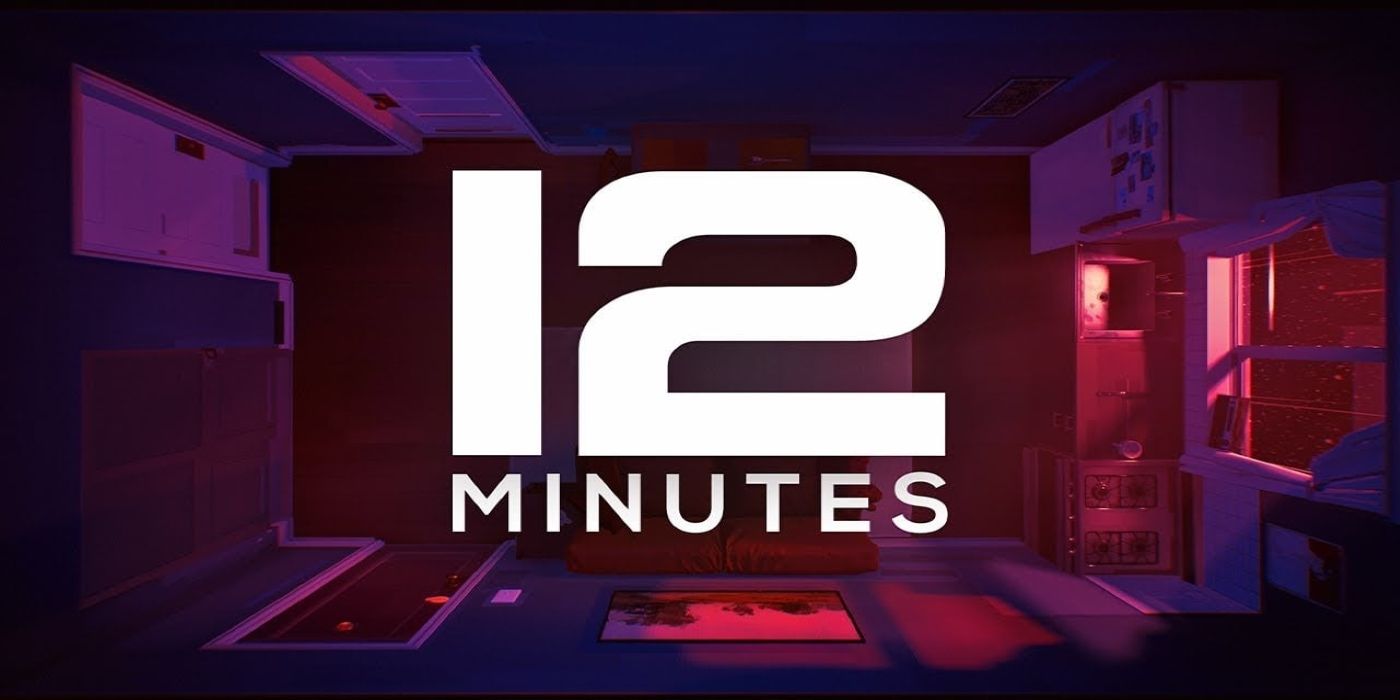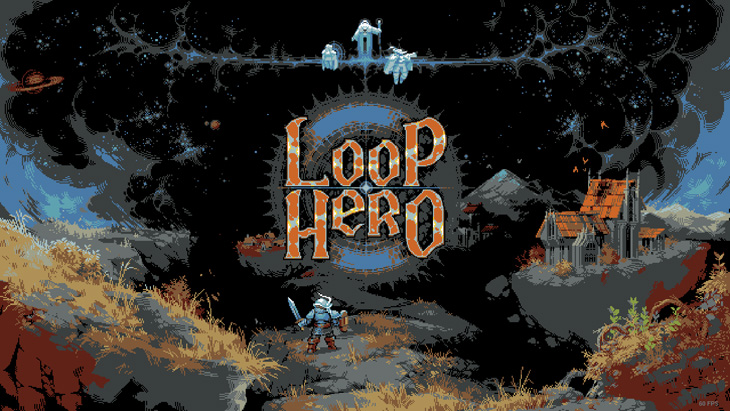
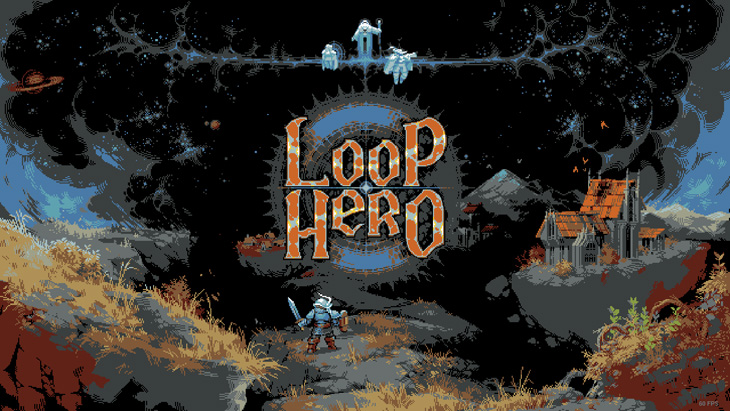
Almost two months ago we previewed the game Loop Hero, and fittingly we’re back here again. Because that’s the theme of Loop Hero; time is a circle. Now that we’ve previewed the game it’s time for a proper review.
Since the preview, the game has been adjusted in many ways. Most notably a stamina bar was added which affects the efficacy of some builds. The things that haven’t changed have been given a more in-depth look.
So is Loop Hero still has good as it was in the preview? Or are the things that make it great, loop back around and become flaws?
Loop Hero
Developer: Four Quarters
Publisher: Devolver Digital
Platforms: Windows PC (Reviewed)
Release Date: February 4, 2021
Players: 1
Price: $14.99 USD
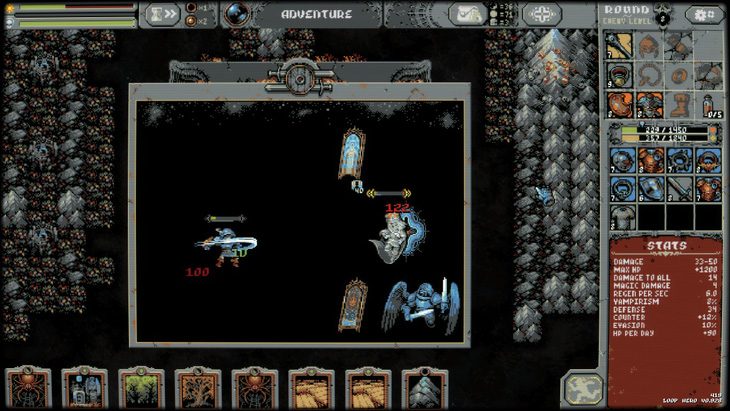
Loop Hero follows the adventures of an unnamed hero who awakens in a void left behind after the world’s destruction. Though dissolution may be more accurate than destruction.
Omicron the Lich has caused the world as it’s known to vanish into nothingness. The hero begins by finding primordial oozes, and slowly “remembering” bits and pieces of the world wills them back into existence. Slowly but surely he succeeds, and a budding camp of other survivors await him.
But each time he goes out, everything is forgotten again. The world outside the camp is wiped clean, and it’s all the hero can do to remember as much as he can in order to draw the ire of the world’s destructors. We soon learn however, that Omicron isn’t acting alone.
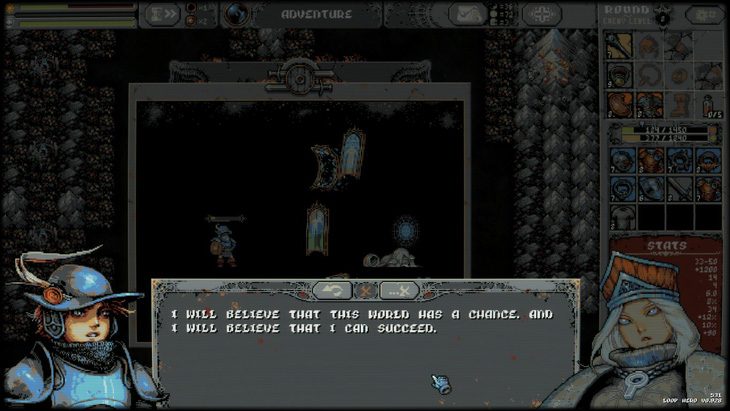
Loop Hero is an adventure roguelite game that’s unique in two ways. The game’s combat is strictly strategic, there’s no active button pressing, and frankly it has more in common with “idle” games.
The other, is the deckbuilding system. Loop Hero is a game about building the board; players start out on a barren track that spawns slimes randomly. Those slimes drop the first cards that will help players seed their world.
Cards that drop are placed on the board, and create a variety of locals and effects. The one exception to this rule is the Oblivion card, which exists to remove misplaced, spontaneously generated tiles, or otherwise inconvenient tiles.
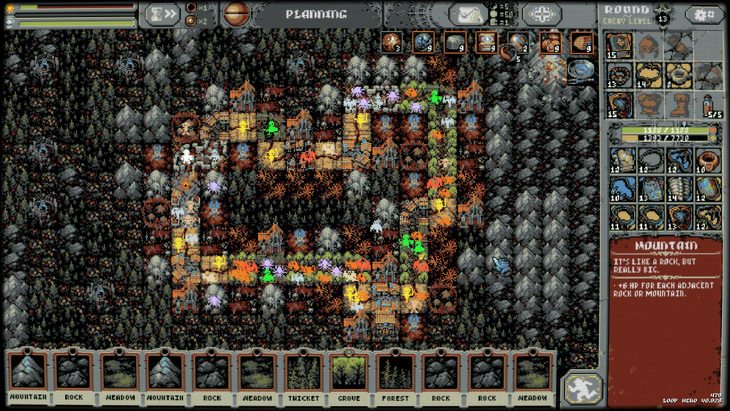
These tiles include things like the Spider Cocoon, the sole purpose of which is to spawn a spider every day. It might seem counter-intuitive to make the loop harder, but that’s where the reward is. Monsters drop gear and cards, which translates into buffs.
Which leads to the next sort of card, terrain tiles that offer static buffs. For example, the mountains grant +6 Max HP and an additional 6 for every adjacent Mountain or Rock card. The Forest and Thicket which grants a +1% and +2% Attack Speed buff each respectively.
The boss only spawns when a meter fills up from placing tiles, and placing those tiles can create more and stronger enemies. The trick is to find a healthy balance. Place tiles that create enough enemies to get gear and cards, and do so without getting overwhelmed and dying.
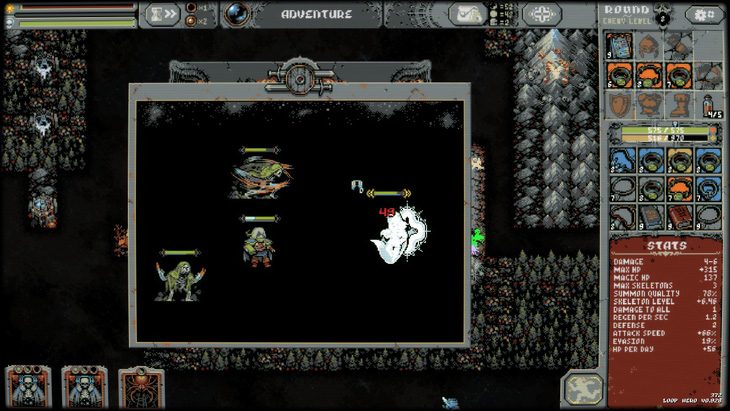
This is made all the more difficult when spontaneous threats generate. For example, placing 10 Rock and Mountain tiles generates a Goblin Camp that spawns a goblin every day on an adjacent tile. Placing 10 Forest and Thicket tiles creates a mysterious village that spawns wooden homunculi that can only counterattack. Careless tile placing can cause unexpected problems.
These can be avoided and controlled in some cases. The most noteworthy example is Bandit Camps. Bandit Camps spawn next to a Village for every 2 Villages placed. However, placing things next to the Village like a Vampire Mansion and Spider Cocoon will prevent the Bandit Camp from spawning.
There’s a layer of depth and strategy to Loop Hero that isn’t immediately apparent, and for better or worse the intricacies aren’t explained. Discovering this depth and secrets keeps you experimenting and making discoveries. For example, placing nine Mountain and Rock tiles in a 3×3 grid creates a large summit. While you may place those tiles together for their synergy, it was something I only through experimentation.
You do get some hints for some synergies early on. Vampires lament over their lost land when first met, and the hero notes they used to protect the territory they owned. While placing a Vampire Mansion next to a Village causes it to be ransacked and spawn Ghouls, after a few loops it becomes the vampire’s lands; complete with villages that heal more and grant better rewards for killing certain monsters.
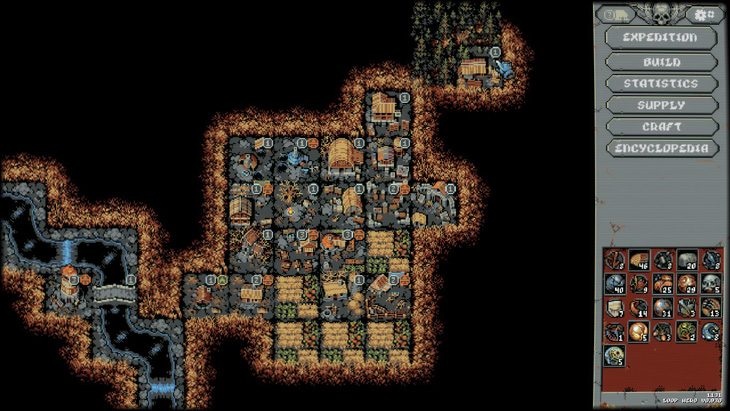
Throughout each expedition, players accumulate resources (up to a cap depending on the map), which are used to improve a base camp. The buildings in the base camp provide buffs, new cards, and other unlocks. So even after defeating a boss, the game necessitates going back to fight previous bosses and hoarding more materials.
At the base camp, players can also equip little knick-knacks that give small buffs like “+2 Damage to Vampires” or “+1 Defense.” Luckily these stack, but they’re earned or crafted randomly, and their benefits are only noticeable when stacked.
As a deckbuilding and strategy game, Loop Hero is a resounding success. It’s fun, innovative, and allows for strategic forethought on the part of the player. If that is purely what you seek, this is well worth playing. If you are seeking a roguelite, the game falls a bit flat in some aspects.
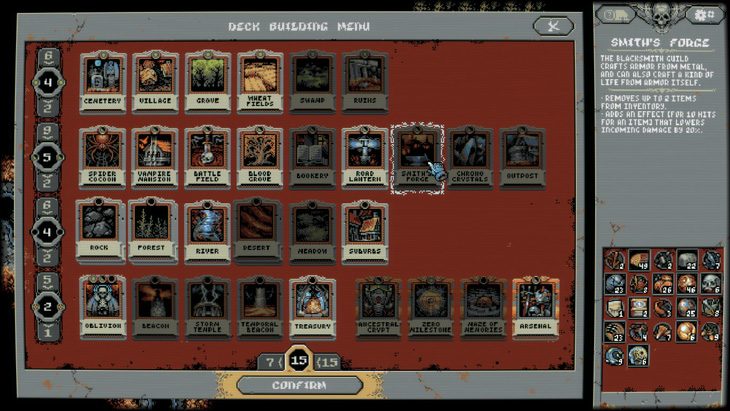
Combat is boring and slow, the two things combat ought not be. Players simply watch the numbers tick away as the fights are resolved automatically. There’s no strategic selection of targets, or special abilities to use. There’s only the dread of watching your hero make terrible decisions with their targeting, like attacking a wooden homunculus while getting shredded by a ratwolf.
Heretical as it sounds, a way to skip viewing combat or speed it up (as you can with the overworld) would be a boon. You can get gear mid-fight from felling foes, and you can examine and equip it (mousing over it and cards pauses combat), but as gear is “forgotten” when removed, you can’t swap out gear for different situations. Its also the limit of control you have in battle.
Not to mention, not all stats are created equally. The existence of Thickets and Forests makes Attack Speed on gear almost entirely irrelevant- should you chose to use those cards in your deck. Falling shy of wanting other synergies, I fail to see why you would want to rely on RNG generated gear stats (which may soon be outpaced by better gear you find) over a card you know will turn up and synergize.
Things like Crit Chance, and Crit Damage for Rogues, are also barely worth stacking when a focus on attack speed will surpass the DPS. Flat Damage, Damage to All, and Defense are more meaningful.
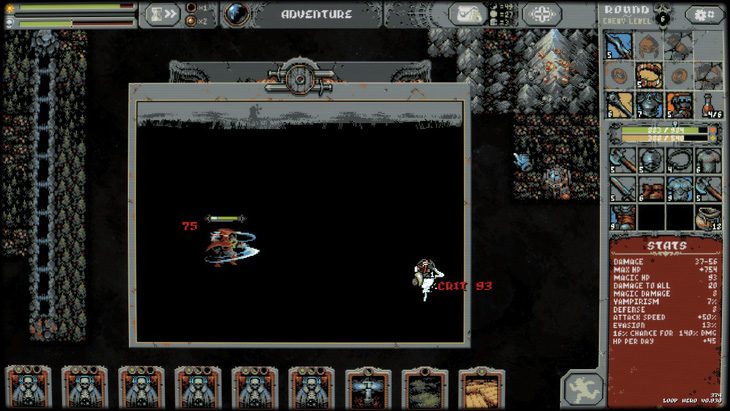
So the game presents you with unengaging and idle combat, while at the same time punishing you for not paying attention to the game. You can only hold so many cards and pieces of gear at once, and if you look away while your hero fights on, you could miss out on a gear upgrade or a new Village to place down.
Ironically, getting lucky with gear makes things easier, but also even more boring. During one expedition on Stage 3 for more materials, I got a good set of gear around my 8th loop and just mindlessly watched the game play itself for about half an hour until my resources began to cap out; my only input in the game was checking the secondary stats on the gear that dropped just in case.
Loop Hero has a great deal of grinding to it. Which is both a problem and a blessing; the grind pads out the content and makes it a game you can easily spend dozens of hours on, but it also gets repetitive quickly.
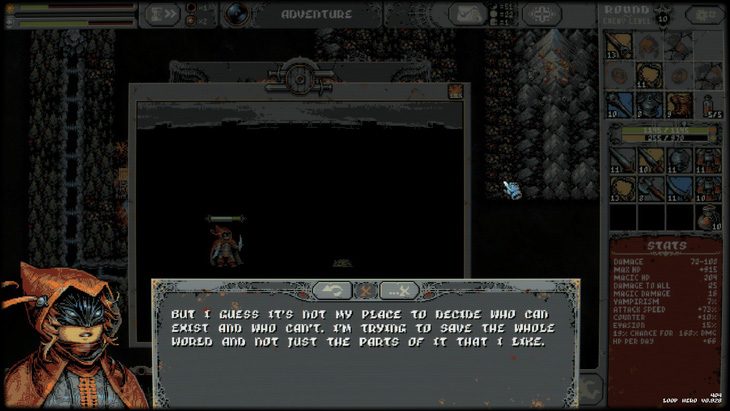
Luckily the art and music of Loop Hero compensates a lot for the flaws of its combat. Loop Hero makes heavy use of pixel art, and goes into grotesque (I mean this in a good way) detail with its enemies and their portraits.
From the mysterious and looming Omicron The Lich, to the yellow-eyed and sadistic Huntsman, to even mundane enemies like the Vampires; the portraits in this game have phenomenally detailed spritework.
The music from the artist Blinch is ominous and spooky during normal play, and manages to keep its 8-bit feel even when it gets a little fancy. However when the boss spawns the music turns up to 11 and changes to a fast-paced showdown beat.
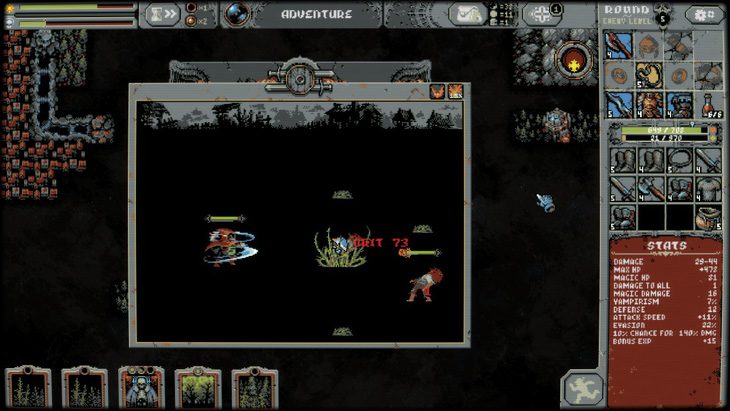
Ultimately, Loop Hero is a strategic roguelite title that shines in its aesthetic, innovation, and depth; only held back in a few areas. These are its lengthy grind, gacha-style knick-knack buffs, and long combat sequences without interaction.
Even so, the satisfaction of building up the world and your hero over and over amidst a challenge can get its hooks deep into you. It’s better to think of it as a strategy game first with roguelite elements, rather than the two being equal or the latter being the main appeal.
Those expecting a traditional roguelite will want to look elsewhere, but those who care more about the feeling of upgrading and constant progression will find a lot to enjoy with Loop Hero.
Loop Hero was reviewed on Windows PC using a copy provided by Devolver Digital. You can find additional information about Niche Gamer’s review/ethics policy here.




